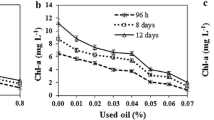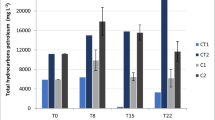Abstract
Although used motor oil from automobiles is one of the major pollutants through storm water in urban environments leading to contamination of water bodies, very little information is available on its toxicity towards growth of microalgae. Also, to our knowledge, there are no data on the used motor oil-induced oxidative stress in microalgae. We therefore investigated the toxicity of used and fresh motor oil on growth and antioxidant enzymes of a microalga, Pseudokirchneriella subcapitata. In general, used oil was more toxic to the alga than fresh oil. Used oil at 0.20 % inhibited algal growth, measured in terms of chlorophyll a, by 44 % while fresh oil was nontoxic up to 2.8 %. Water-accommodated fraction (WAF) of the used oil at >50 % concentration exhibited significant toxicity while WAF from fresh oil was nontoxic even up to 100 %. Used oil and its WAF, even at lower concentrations, increased the levels of antioxidant enzymes indicating algal response to the toxicity stress. When the alga was exposed to WAF from fresh motor oil, no alterations in the antioxidant enzyme levels were evident. The present investigation suggests that contamination of aquatic systems with used oil could potentially affect the ecosystem health via disruption of primary producers that are located at the base of the food chain.






Similar content being viewed by others
References
Anderson J, Neff J, Cox B, Tatem H, Hightower G (1974) Characteristics of dispersions and water-soluble extracts of crude and refined oils and their toxicity to estuarine crustaceans and fish. Mar Biol 27:75–88
Beers RF, Sizer IW (1952) A spectrophotometric method for measuring the breakdown of hydrogen peroxide by catalase. J Biol Chem 195:133–140
Bejarano AC, Chandler GT, He L, Coull BC (2006) Individual to population level effects of South Louisiana crude oil water accommodated hydrocarbon fraction (WAF) on a marine meiobenthic copepod. J Exp Mar Biol Ecol 332:49–59
Bott TL, Rogenmuser K (1978) Effects of no. 2 fuel oil, Nigerian crude oil, and used crankcase oil on attached algal communities: acute and chronic toxicity of water-soluble constituents. Appl Environ Microbiol 36:673–682
Bradford MM (1976) A rapid and sensitive method for the quantitation of microgram quantities of protein utilizing the principle of protein-dye binding. Anal Biochem 72:248–254
Cecutti C, Agius D (2008) Ecotoxicity and biodegradability in soil and aqueous media of lubricants used in forestry applications. Bioresour Technol 99:8492–8496
Chance B, Maehly AC (1955) Assays of catalases and peroxidases. In: Colowic SP, Kaplan NO (eds) Methods of enzymology. Academic, New York, pp 764–775
Deasi S, Verlecar X, Ansari Z, Jagtap T, Sarkar A, Vashistha D, Dalal S (2010) Evaluation of genotoxic responses of Chaetoceros tenuissimus and Skeletonema costatum to water accommodated fraction of petroleum hydrocarbons as biomarker of exposure. Water Res 44(7):2235–2244
Faksness LG, Brandvik PJ (2008) Distribution of water soluble components from Arctic marine oil spills—a combined laboratory and field study. Cold Reg Sci Technol 54:97–105
Fleeger JW, Carman KR, Nisbet RM (2003) Indirect effects of contaminants in aquatic ecosystems. Sci Tot Environ 317:207–233
Gill SS, Tuteja N (2010) Reactive oxygen species and antioxidant machinery in abiotic stress tolerance in crop plants. Plant Physiol Biochem 48:909–930
Ikawa M, Sasner JJ, Haney JF (1997) Inhibition of Chlorella growth by degradation and related products of linoleic and linolenic acids and the possible significance of polyunsaturated fatty acids in phytoplankton ecology. Hydrobiol 356:143–148
Ke L, Luo L, Wang P, Luan T, Tam NFY (2010) Effects of metals on biosorption and biodegradation of mixed polycyclic aromatic hydrocarbons by a freshwater green alga Selenastrum capricornutum. Bioresour Technol 101:6950–6961
Kim WK, Park JW, Lim ES, Lee SK, Kim J, Kim S, Lee SW, Choi K, Jung J (2014) Tissue-specific antioxidant responses in pale chub (Zacco platypus) exposed to copper and benzo[a]pyrene. Bull Environ Contam Toxicol 92:540–545
Li M, Gao X, Wu B, Qian X, Giesy J, Cui Y (2014) Microalga Euglena as a bioindicator for testing genotoxic potentials of organic pollutants in Taihu Lake, China. Ecotoxicol 23:633–640
Lei AP, Wong YS, Tam NF (2002) Removal of pyrene by different microalgal species. Water Sci Technol 46:195–201
Lei A, Hu Z, Wong Y, Tam NF (2006) Antioxidant responses of microalgal species to pyrene. J Appl Phycol 18:67–78
Martínez JF, Villaseñor R, Ríos G, Espinosa-Chavez F (2005) Toxicity of the crude oil water-soluble fraction and kaolin-adsorbed crude oil on Daphnia magna (Crustacea: Anomopoda). Arch Environ Contam Toxicol 48:444–449
McCord JM, Fridovich I (1969) Superoxide dismutase. J Biol Chem 244:6049–6055
Megharaj M, Venkateswarlu K, Rao A (1986) Growth response of four species of soil algae to monocrotophos and quinalphos. Environ Pollut A42:15–22
Megharaj M, Singleton I, Kookana R, Naidu R (1999) Persistence and effects of fenamiphos on native algal populations and enzymatic activities in soil. Soil Biol Biochem 31:1549–1553
Migdal C, Serres M (2011) Reactive oxygen species and oxidative stress. Med Sci 27:405–412
Nayar S, Goh B, Chou L (2005) Environmental impacts of diesel fuel on bacteria and phytoplankton in a tropical estuary assessed using in situ mesocosms. Ecotoxicol 14:397–412
Nechev J, Khotimchenko SV, Ivanova AP, Stefanov KL, Dimitrova-Konaklieva SD, Andreev S, Popov SS (2002) Effect of diesel fuel pollution on the lipid composition of some wide-spread Black sea algae and invertebrates. Zeit Naturforscf C 57:339–343
Ogali RE, Osuji LC, Ayodele O (2007) Acute toxicity of the water-soluble fraction of spent lubricating oil on the African catfish Clarias gariepinus. Chem Biodiver 4:2755–2765
Okamoto OK, Pinto E, Latorre LR, Bechara EJH, Colepicolo P (2001) Antioxidant modulation in response to metal-induced oxidative stress in algal chloroplasts. Arch Environ Contam Toxicol 40:18–24
Palma P, Palma VL, Fernandes RM, Soares AMVM, Barbosa IR (2008) Acute toxicity of atrazine, endosulfan sulphate and chlorpyrifos to Vibrio fischeri, Thamnocephalus platyurus and Daphnia magna, relative to their concentrations in surface waters from the Alentejo Region of Portugal. Bull Environ Contam Toxicol 81:485–489
Piehler M, Winkelmann V, Twomey L, Hall N, Currin C, Paerl H (2003) Impacts of diesel fuel exposure on the microphytobenthic community of an intertidal sand flat. J Exp Mar Biol Ecol 297:219–237
Pirro D, Wessol A (2001) Lubrication fundamentals, 2nd edn. Marcel Dekker Inc., New York
Pinto E, Sigaud kutner T, Leitao MAS, Okamoto OK, Morse D, Colepicolo P (2003) Heavy metal induced stress in algae. J Phycol 39:1008–1018
Ramakrishnan B, Megharaj M, Venkateswarlu K, Naidu R, Sethunathan N (2010) The impacts of environmental pollutants on microalgae and cyanobacteria. Crit Rev Environ Sci Technol 40:699–821
Reynolds CS (1998) Plants in motion: physical-biological interaction in the plankton. Coast Estuar Stud 54:535–560
Risdon GC, Pollard SJT, Brassington KJ, McEwan JN, Paton GI, Semple KT, Coulon F (2008) Development of an analytical procedure for weathered hydrocarbon contaminated soils within a UK risk-based framework. Anal Chem 80:7090–7096
Roseth S, Edvardsson T, Botten MT, Fuglestad J, Fonnum F, Stenersen JO (1996) Comparison of acute toxicity of process chemicals used in the oil refinery industry, tested with the diatom Chaetoceros gracilis, the flagellate Isochrysis galbana, and the zebra fish, Brachydanio rerio. Environ Toxicol Chem 15:1211–1217
Sepcic KH (2003) Quantification of volatile compounds in degraded engine oil. PhD, Goergia Tech University
Singer M, Aurand D, Bragin G, Clark J, Coelho G, Sowby M, Tjeerdema R (2000) Standardization of the preparation and quantitation of water-accommodated fractions of petroleum for toxicity testing. Mar Pollut Bull 40:1007–1016
Singh A, Gaur J (1990) Effects of petroleum oils and their paraffinic, asphaltic, and aromatic fractions on photosynthesis and respiration of microalgae. Ecotoxicol Environ Saf 19:8–16
Singh SK, Agarwal AK, Sharma M (2006) Experimental investigations of heavy metal addition in lubricating oil and soot deposition in an EGR operated engine. Appl Therm Eng 26:259–266
Ssempebwa JC, Carpenter DO, Yilmaz B, DeCaprio AP, O'Hehir DJ, Arcaro KF (2004) Waste crankcase oil: an environmental contaminant with potential to modulate estrogenic responses. J Environ Sci Heal A 67:1081–1094
Subashchandrabose SR, Megharaj M, Venkateswarlu K, Naidu R (2013) Interaction effects of polycyclic aromatic hydrocarbons and heavy metals on a soil microalga, Chlorococcum sp. MM11. Environ Sci Pollut Res. doi:10.1007/s11356-013-1679-9
Subashchandrabose SR, Megharaj M, Venkateswarlu K, Naidu R (2012) p‐Nitrophenol toxicity to and its removal by three select soil isolates of microalgae: the role of antioxidants. Environ Toxicol Chem 31:1980–1988
Tam NFY, Wong TWY, Wong Y (2005) A case study on fuel oil contamination in a mangrove swamp in Hong Kong. Mar Pollut Bull 51:1092–1100
Thavamani P, Megharaj M, Naidu R (2012) Multivariate analysis of mixed contaminants (PAHs and heavy metals) at manufactured gas plant site soils. Environ Monit Assess 184:3875–3885
Torres MA, Barros MP, Campos SCG, Pinto E, Rajamani S, Sayre RT, Colepicolo P (2008) Biochemical biomarkers in algae and marine pollution: a review. Ecotoxicol Environ Saf 71:1–15
US EPA (1989) Algal (Selenastrum capricornutum) growth test. Short-term methods for estimating the chronic toxicity of effluents and receiving waters to freshwater organisms. Environmental Monitoring Systems Laboratory, Environmental Protection Agency, Cincinnati, Ohio
US EPA (2000) Ecological soil screening level guidance (Draft). Office of emergency and remedial response. US Environmental Protection Agency, Washington, DC, USA
Vazquez-Duhalt R (1989) Environmental impact of used motor oil. Sci Tot Environ 79:1–23
Wang Z, Yang C, Kelly-Hooper F, Hollebone B, Peng X, Brown C, Landriault M, Sun J, Yang Z (2009) Forensic differentiation of biogenic organic compounds from petroleum hydrocarbons in biogenic and petrogenic compounds cross-contaminated soils and sediments. J Chromatogr A 1216(7):1174–1191
Wong PK, Wang J (2001) The accumulation of polycyclic aromatic hydrocarbons in lubricating oil over time—a comparison of supercritical fluid and liquid-liquid extraction methods. Environ Pollut 112:407–415
Zawadzki Z, Langowska I (1983) Studies on the utilization of octane by algae. Acta Microbiol Polon 32:191–196
Acknowledgments
This research was supported by the Australian Government, University of South Australia through an IPRS scholarship to KR and CRC for Contamination Assessment and Remediation of the Environment.
Author information
Authors and Affiliations
Corresponding author
Additional information
Responsible editor: Philippe Garrigues
Rights and permissions
About this article
Cite this article
Ramadass, K., Megharaj, M., Venkateswarlu, K. et al. Toxicity and oxidative stress induced by used and unused motor oil on freshwater microalga, Pseudokirchneriella subcapitata . Environ Sci Pollut Res 22, 8890–8901 (2015). https://doi.org/10.1007/s11356-014-3403-9
Received:
Accepted:
Published:
Issue Date:
DOI: https://doi.org/10.1007/s11356-014-3403-9




